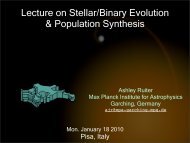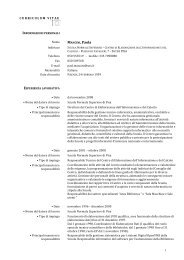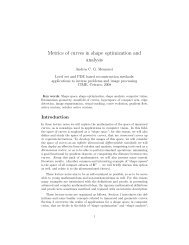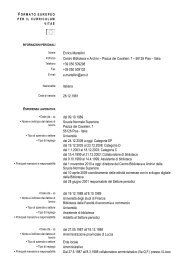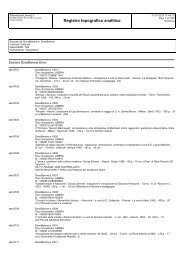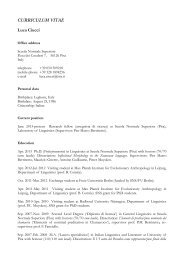Non-conventional uses of the Pluperfect entional uses of the ...
Non-conventional uses of the Pluperfect entional uses of the ...
Non-conventional uses of the Pluperfect entional uses of the ...
Create successful ePaper yourself
Turn your PDF publications into a flip-book with our unique Google optimized e-Paper software.
Pier Marco Bertinetto<strong>Non</strong>-conv<strong>conv<strong>entional</strong></strong> <strong>uses</strong> <strong>of</strong> <strong>the</strong> <strong>Pluperfect</strong> in <strong>the</strong> Italian (and German)literary prose(to appear in a collective volume)1 IntroductionThe ordinary interpretation <strong>of</strong> <strong>the</strong> <strong>Pluperfect</strong> (henceforth PPFPF) is straightforward. 1Using Reichenbach’s (1947) conventions, an event (E) expressed by <strong>the</strong> PPF occursbefore <strong>the</strong> Speech Time (S), but after a contextually determined Reference Time (R).As has been pointed out (cf., e.g., Bertinetto 1986), <strong>the</strong> semantic representation <strong>of</strong> thistense refers to two structural levels: TEMPORALITY, inasmuch as it is coded as a pasttense,and ASPECT, inasmuch as it involves <strong>the</strong> subjective choice <strong>of</strong> a suitable R, asrequired by all perfect-tenses. Although <strong>the</strong> PPF is not to be found in <strong>the</strong> tense-system<strong>of</strong> all natural languages, whenever it appears it seems to exhibit, by and large, <strong>the</strong>same semantic representation – at least with reference to its prototypical <strong>uses</strong> – as wellas a remarkable diachronic stability. Needless to say, <strong>the</strong> last statement should be readcum grano salis. Depending on <strong>the</strong> language, <strong>the</strong> PPF may marginally exhibit peculiarsemantic properties; 2 besides, in some cases two competing tenses, with slightly1The reader should be aware <strong>of</strong> <strong>the</strong> conventions adopted in this paper. First, capital initials are used todesignate <strong>the</strong> tenses belonging to language-specific grammatical descriptions. Thus, <strong>the</strong> “PresentPerfect” to be found in <strong>the</strong> English tense-aspect system appears with capital initials, while no capital isused when <strong>the</strong> term “present-perfect” refers to <strong>the</strong> aspectual domain. Second, <strong>the</strong> word “tense” isrestricted to grammar-specific designations, while <strong>the</strong> semantic domain frequently (and confusingly)referred to by <strong>the</strong> same term is called “temporality” in this paper (a possible alternative is “temporalreference”). The following ABBREVIATIONS are used throughout: Ant/PPF = anteriority <strong>Pluperfect</strong>;Aor/ PPF = aoristic <strong>Pluperfect</strong>; CP = Compound Past; GR = Gerund; IPF = Imperfect; PPF =<strong>Pluperfect</strong>; PPT = Past Participle; PRS = Present; PR-IPF = Progressive Imperfect; SJ-... =Subjunctive ...; SP = Simple Past.2One might recall, e.g., <strong>the</strong> counterfactual PPF to be found in English hypo<strong>the</strong>tical protases, such as:[i]Had she been more careful, <strong>the</strong> accident would not have happened.
QUADERNI DEL LABORATORIO DI LINGUISTICA – VOL. 9,2/2010different semantic properties, may fill in <strong>the</strong> PPF slot. 3 To <strong>the</strong> extent, however, that <strong>the</strong>above statement is true, it is in striking contrast with <strong>the</strong> situation to be found withano<strong>the</strong>r member <strong>of</strong> <strong>the</strong> perfect-tenses set, namely <strong>the</strong> Present Perfect, characterized byconsiderable diachronic instability, namely by its cross-linguistic tendency to shiftfrom <strong>the</strong> domain <strong>of</strong> <strong>the</strong> perfect into <strong>the</strong> domain <strong>of</strong> pure perfectivity, or “aoristicity”.Assuming <strong>the</strong> given background, this paper will address a somehow deviant usage<strong>of</strong> <strong>the</strong> PPF in Italian and (tentatively) German. The examples are taken from literarytexts, for <strong>the</strong>y <strong>of</strong>fer a better illustration <strong>of</strong> <strong>the</strong> issue, but this should not be interpretedas entailing that <strong>the</strong> phenomenon at hand does not emerge in <strong>the</strong> colloquial registers.The temporal architecture <strong>of</strong> all narrative texts – including <strong>the</strong> oral ones – rests on<strong>the</strong> so-called “propulsive” tenses, <strong>the</strong> ones that have <strong>the</strong> capacity <strong>of</strong> pushing forward,so to say, <strong>the</strong> thread-<strong>of</strong>-discourse. In literary narrative texts, in particular, <strong>the</strong>propulsive function is standardly – i.e., traditionally – assigned to aoristic pasts (cf. <strong>the</strong>Fr. Passé Simple or <strong>the</strong> It. Passato Semplice, traditionally called Passato Remoto), orat least tenses that may take on this interpretation although this is not <strong>the</strong>ir onlyreading (cf. <strong>the</strong> Eng. Simple Past). Occasionally, <strong>the</strong> propulsive function may betransferred to o<strong>the</strong>r tenses, like <strong>the</strong> “narrative” Present in <strong>the</strong> European literarytradition. In oral narratives, <strong>the</strong> use <strong>of</strong> <strong>the</strong> Present as a propulsive tense, in alternationwith <strong>the</strong> perfective Past(s), is fairly frequent. Depending on <strong>the</strong> degree <strong>of</strong> involvement<strong>of</strong> <strong>the</strong> speaker, o<strong>the</strong>r possibilities may emerge, such as <strong>the</strong> alternation <strong>of</strong> Simple vs.Compound Past in Romance. 4 Interestingly, many languages – most notably among______________________________________________________________________This expansion into <strong>the</strong> domain <strong>of</strong> modality is obviously less viable, e.g., in Italian (where it isrestricted to stylistically substandard usages) due to <strong>the</strong> division <strong>of</strong> labor between Indicative andSubjunctive PPF. Needless to say, <strong>the</strong> existence <strong>of</strong> PPF tenses in different moods is a highly interestingtopic, which however this paper does not address. To <strong>the</strong> extent that Subjunctive <strong>Pluperfect</strong>s will showup in <strong>the</strong> examples presented below, <strong>the</strong> analysis will be restricted to <strong>the</strong>ir temporal-aspectual meaning,while <strong>the</strong>ir modality component will not be discussed.3A case in point is Italian, with two <strong>Pluperfect</strong>s in <strong>the</strong> indicative mood (apart from <strong>the</strong> SubjunctivePPF), traditionally called Trapassato Prossimo and Trapassato Remoto (Piucheperfetto and Trapassato inBertinetto 1986). The examples to be discussed in this paper are however limited to <strong>the</strong> most frequent(and semantically unconstrained) alternative, namely <strong>the</strong> PPF (Piucheperfetto). For a discussion <strong>of</strong> <strong>the</strong>structural differences between <strong>the</strong>se two forms, see Bertinetto (1987).4The use <strong>of</strong> <strong>the</strong> “narrative” Present in English oral narratives, and its strategic alternation with <strong>the</strong>Simple Past, has been extensively studied at least since Wolfson (1979), Schiffrin (1981) and Silva-Corvalán (1983). As for <strong>the</strong> alternation between Simple vs. Compound Past, <strong>the</strong> issue was dealt with at2
QUADERNI DEL LABORATORIO DI LINGUISTICA – VOL. 9,2/2010those spoken in Africa – even dispose <strong>of</strong> a specific (set <strong>of</strong>) “narrative” tense(s), onlyto be used in this type <strong>of</strong> texts, traditionally produced in oral form. Apparently, this isnot <strong>the</strong> case in <strong>the</strong> European languages, where <strong>the</strong> typically propulsive tenses have, toa lesser <strong>of</strong> larger extent, a wider usage potential. However, on close inspection it turnsout that something <strong>of</strong> <strong>the</strong> sort may be detected even in <strong>the</strong> European literary tradition.Indeed, in literary narratives <strong>the</strong> propulsive function is fulfilled by tenses which,although far from unmarked in general, should be regarded as unmarked precisely insuch contexts. The reason for this is straightforward, as noted by Fludernik (1993).The tense-aspect system underlying oral linguistic productions is anchored on <strong>the</strong>Speech Time, acting as <strong>the</strong> deictic pole <strong>of</strong> attraction. Thus, <strong>the</strong> Present is <strong>the</strong> unmarkedtense in normal situations. In literary texts, by contrast, an imaginary “Speech Time”is <strong>conv<strong>entional</strong></strong>ly adopted, ostensibly distinct from <strong>the</strong> hic et nunc <strong>of</strong> <strong>the</strong> act <strong>of</strong> writingand assumed to be localized in a fictional past, even when <strong>the</strong> author describes a futureworld (as is typical <strong>of</strong> science-fiction narratives). This fictional anchoring time,implicitly shared by <strong>the</strong> reader, produces a thorough reorientation <strong>of</strong> <strong>the</strong> time-axis, to<strong>the</strong> effect that <strong>the</strong> propulsive Past becomes, in such contexts, <strong>the</strong> unmarked tensearound which <strong>the</strong> whole system recalibrates itself.In recent times, several attempts have been made in different literary environmentsto renew <strong>the</strong> narrative strategies, by promoting to propulsive function tenses that weretraditionally alien to it. The present author has demonstrated this with examples drawnfrom <strong>the</strong> Italian literature <strong>of</strong> <strong>the</strong> past few decades (Bertinetto 2001; 2003, ch. 2). One<strong>of</strong> <strong>the</strong> devices exploited to this effect is <strong>the</strong> use <strong>of</strong> <strong>the</strong> PPF as an alternative to <strong>the</strong>Simple Past. This study extends <strong>the</strong> analysis with fur<strong>the</strong>r examples.2 Anteriority <strong>Pluperfect</strong> vs. aoristic <strong>Pluperfect</strong>Assuming Reichenbach’s (1947) classical proposal, <strong>the</strong> semantic representation <strong>of</strong><strong>the</strong> PPF’s protopypical <strong>uses</strong> may be symbolized as in <strong>the</strong> following diagram. Thelocalization <strong>of</strong> R can be explicit or implicit, as shown in [1]:______________________________________________________________________length in Weinrich’s (1964) seminal work, although <strong>the</strong> conclusions arrived at appear to be ra<strong>the</strong>raprioristic according to <strong>the</strong> present author.3
QUADERNI DEL LABORATORIO DI LINGUISTICA – VOL. 9,2/2010Prototypical structure <strong>of</strong> <strong>the</strong> PPF___________E______R______________S___________[1] a. At 5 o’clock, Peter had already left [explicit R-localization]b. Peter had already left at 5 o’ clock. [implicit R-localization]Although <strong>the</strong> linguistic material is <strong>the</strong> same in both cases, <strong>the</strong> informational contentand its syntactic implementation (not discussed here) are radically different. Thetemporal adverbial at 5 o’clock plays a different role in <strong>the</strong> two sentences. In (a), itfulfills <strong>the</strong> R role, while <strong>the</strong> localization <strong>of</strong> E is left vague. In (b), instead, <strong>the</strong>adverbial explicitly localizes E, while R has to be recovered from <strong>the</strong> precedingcontext. 5 The two sentences are thus symmetric in terms <strong>of</strong> explicitness: (a) makes Rexplicit, while leaving E’s localization vague; in (b) <strong>the</strong> contrary occurs. The doublereading possibility <strong>of</strong> examples such as those in [1] was already noted by Reichenbachin his seminal work, with a slightly different interpretation. But whatever <strong>the</strong>interpretation <strong>of</strong> <strong>the</strong> adverbial (as ei<strong>the</strong>r R or localizer <strong>of</strong> E), it is important to observein this context that <strong>the</strong> aspectual structure <strong>of</strong> <strong>the</strong> PPF is <strong>the</strong> same in both cases.The above structure is also to be found in o<strong>the</strong>r more specific, yet fairly traditional<strong>uses</strong> <strong>of</strong> <strong>the</strong> PPF, like <strong>the</strong> so-called ‘explanatory’ PPF. This is associated with sentencessuch as [2], where <strong>the</strong> natural sequence <strong>of</strong> <strong>the</strong> events is reversed (aniconical order) and<strong>the</strong> second clause provides an explanation for <strong>the</strong> unexpected situation depicted by <strong>the</strong>preceding one. Here <strong>the</strong> first clause plays <strong>the</strong> role <strong>of</strong> R, while E’s localization remainsvague:[2] It was completely dark. Somebody had disconnected <strong>the</strong> electricity.An important fact to be retained from <strong>the</strong> above discussion is that, whenever a PPFis met, <strong>the</strong> hearer/reader starts <strong>the</strong> search for a suitable R in order to saturate thisindispensable structural projection. Should <strong>the</strong> immediately previous context notprovide a viable R, <strong>the</strong> search continues until saturation occurs, for this is strictlyrequired by <strong>the</strong> aspectual nature <strong>of</strong> <strong>the</strong> ordinary PPF. Indeed, an abrupt story’s5The reader can easily construe a plausible context with a little exercise <strong>of</strong> imagination. The tworeadings <strong>of</strong> <strong>the</strong> PPF in [1] were respectively called “perfect-in-<strong>the</strong>-past” and “past-in-<strong>the</strong>-past” byComrie (1976: 56). Although in most languages <strong>the</strong>y are conveyed by one and <strong>the</strong> same form, Squartini(1999) has shown that this is not always <strong>the</strong> case, with examples from Portuguese and Zürich German.4
QUADERNI DEL LABORATORIO DI LINGUISTICA – VOL. 9,2/2010beginning such as Mary had forgotten <strong>the</strong> car’s key immediately prompts <strong>the</strong>hearer/reader to locate R at a <strong>conv<strong>entional</strong></strong> point-in-time, to be identified with <strong>the</strong>current stage <strong>of</strong> <strong>the</strong> plot, such that <strong>the</strong> event <strong>of</strong> forgetting must have occurred at someundefined moment preceding <strong>the</strong> given temporal stage.Despite <strong>the</strong> fairly robust stability <strong>of</strong> <strong>the</strong> PPF’s representation, in some languages oneobserves a growing tendency <strong>of</strong> <strong>the</strong> PPF to be used in purely aoristic contexts, i.e. asan alternative to <strong>the</strong> purely perfective Past(s). This is notably <strong>the</strong> case as far as <strong>the</strong>propulsive function <strong>of</strong> literary narratives is concerned, but <strong>the</strong> same tendency may beobserved in spontaneous oral usage. A number <strong>of</strong> examples will be provided below.This may be understood as a development subsequent – but connected to – <strong>the</strong>tendency <strong>of</strong> <strong>the</strong> present-perfect to invade <strong>the</strong> aorist’s territory This well-known drift,which might be called called “Perfektschwund”, 6 has been pointed out for severalunrelated languages and at different diachronic stages, and appears to be a sort <strong>of</strong>cognitive constant underlying <strong>the</strong> unstable relation opposing present-perfect and aorist.The delicate texture <strong>of</strong> <strong>the</strong> present-perfect, as indicating <strong>the</strong> “current relevance <strong>of</strong> apast event”, <strong>of</strong>ten tends to gradually shift into <strong>the</strong> (aspectually quite distinct) notion <strong>of</strong>“event concluded in <strong>the</strong> past”. Squartini & Bertinetto (2000) analyzed this diachronicprocess in <strong>the</strong> Romance languages, also pointing out alternative solutions (like <strong>the</strong>unusual division <strong>of</strong> labor between Simple vs. Compound Past in Portuguese). Thepoint to be retained here is that <strong>the</strong> analogous, although less widespread, shift <strong>of</strong> <strong>the</strong>PPF into <strong>the</strong> aoristic-aspect area <strong>of</strong> pure perfectivity seems to be ano<strong>the</strong>r instance <strong>of</strong><strong>the</strong> general drift consisting in <strong>the</strong> loss <strong>of</strong> aspectual specificity by <strong>the</strong> perfect-tenses(aoristic-drift). 7From <strong>the</strong> structural-semantic point <strong>of</strong> view, this phenomenon corresponds to <strong>the</strong>loss <strong>of</strong> <strong>the</strong> R component. This applies to both <strong>the</strong> present-perfect and <strong>the</strong> PPF in <strong>the</strong>iraoristic <strong>uses</strong>. The illustration in [3] is limited to <strong>the</strong> former tense, but <strong>the</strong> situation <strong>of</strong><strong>the</strong> aoristic PPF is, mutatis mutandis, identical:[3] a. John has broken his left arm while jumping over a fence.6The inspiration stems from <strong>the</strong> term “Praeteritumschwund”, apparently introduced by Leo Spitzer(1929). See also Drinka (2004). Thanks are due to Mario Squartini for providing <strong>the</strong>se references.7Although <strong>the</strong> aoristic-drift is mainly known with reference to <strong>the</strong> shift from present-perfect to aorist(Perfektschwund), <strong>the</strong> analogous change concerning <strong>the</strong> PPF is more widespread than normallyassumed. As Haverling (2005; 2008) shows, this process occurred in Late Latin, with forms such asinventum fuerat instead <strong>of</strong> Class. Lat. inventum erat ‘it had been found’.5
QUADERNI DEL LABORATORIO DI LINGUISTICA – VOL. 9,2/2010b. * Last Tuesday, John has broken his left arm while jumping over a fence.c. Last Tuesday, John broke his left arm while jumping over a fence.d. Martedì scorso, Gianni si è rotto / si ruppe il braccio sinistro saltando una siepe.As has been repeatedly pointed out, a sentence such as (b) is ungrammatical in mostEnglish dialects, for <strong>the</strong> current relevance associated to <strong>the</strong> Present Perfect isincompatible with <strong>the</strong> concomitant localization <strong>of</strong> E within <strong>the</strong> same sentence (itmight, though, be stated in a syntactically separate sentence). The Simple Past in (c)amends this fault, for its semantic representation does not presuppose <strong>the</strong> presence <strong>of</strong><strong>the</strong> R component, at least in <strong>the</strong> approach proposed by Bertinetto (1982; 1986): <strong>the</strong>Eng. Simple Past merely implements a deictic relation between S and E and thusallows <strong>the</strong> explicit localization <strong>of</strong> <strong>the</strong> latter component. The reason why R and Ecannot both be localized within <strong>the</strong> boundary <strong>of</strong> one and <strong>the</strong> same sentence (with, to<strong>the</strong> best <strong>of</strong> <strong>the</strong> present knowledge, only one very specific exception, as shown inBertinetto 1982 and 1986) is a poorly understood fact, which this paper does notaddress. Suffice it to say that it is an observationally very robust datum and it will thusbe taken for granted in what follows. Sentence (d) is <strong>the</strong> Italian translation <strong>of</strong> (c), withone notable difference: <strong>the</strong> sentence contains two alternatives, <strong>the</strong> Compound and <strong>the</strong>Simple Past (in this order), which in <strong>the</strong> given context turn out to be equivalent. Thechoice between <strong>the</strong> one and <strong>the</strong> o<strong>the</strong>r form is largely dependent on <strong>the</strong> languagevariety spoken by <strong>the</strong> individual speaker (Bertinetto & Squartini 1996). Needless tosay, <strong>the</strong>se two tenses are not equivalent in every context, but <strong>the</strong> point at issue here isthat, given <strong>the</strong> appropriate context, <strong>the</strong>y may turn out to be interchangeable. Thisshows that in at least some cases, and in <strong>the</strong> relevant language varieties, <strong>the</strong> It.Compound Past, by losing <strong>the</strong> R component, replaces <strong>the</strong> original semanticrepresentation – that <strong>of</strong> <strong>the</strong> prototypical present-perfect – with <strong>the</strong> one pertaining to <strong>the</strong>aoristic (purely perfective) past, as shown in <strong>the</strong> following diagram:(a) present-perfect____E__________S,R____(b) aoristic past____E___________S____Interestingly, in Ancient Italian a somehow opposite tendency was at work, for <strong>the</strong>Simple Past could <strong>of</strong>ten be used instead <strong>of</strong> a PPF. This can still be observed in modern6
QUADERNI DEL LABORATORIO DI LINGUISTICA – VOL. 9,2/2010literature, although much less frequently. Example [4] shows this with <strong>the</strong> first twoSimple Pasts, whose temporal localization is <strong>the</strong> same as that <strong>of</strong> <strong>the</strong> following PPF: 8[4] Renato Fucini, All'aria aperta (1887), Roma, Newton Compton 1978 (p.154)Purtroppo il dottore non sbagliò SP-1 quando, dopo aver tentato ogni mezzosuggeritogli dalla sua scienza, dichiarò SP-2 incurabile il fanciullo e gravissime eirrimediabili le lesioni prodotte alla spina dalla caduta. « Forse vivrà, » aveva detto PPFil dottore, «vivrà per mezzo di cure speciali ed assidue, ma di una vita languida edolorosa; e non potrà mai servirsi delle sue gambe ». E il presagio non fallì SP-3.[Unfortunately, <strong>the</strong> doctor did not make a mistake SP-1 when... he stated SP-2 ...“Perhaps he will survive», <strong>the</strong> doctor had said PPF ... This prediction came out true SP-3.]It would be farfetched to state that <strong>the</strong> above-mentioned Simple Pasts project anadditional R component in <strong>the</strong>ir semantic representation. It is a fact, however, that <strong>the</strong>latent presence <strong>of</strong> this component may be reconstructed due to context redundance.Coming back to <strong>the</strong> issue <strong>of</strong> <strong>the</strong> aoristic PPF, it should be mentioned that Bertinetto& Squartini [1996], in a study devoted to <strong>the</strong> assessment <strong>of</strong> <strong>the</strong> Simple vs. CompoundPast usage in a number <strong>of</strong> geographically-distinct varieties <strong>of</strong> Italian, sporadicallycollected unexpected examples <strong>of</strong> Aor/PPF in <strong>the</strong> questionnaire responses. Thisinvariably occurred in contexts which forced an aoristic, ra<strong>the</strong>r than perfect, view. Thisconfirms <strong>the</strong> impression that this marginal use <strong>of</strong> <strong>the</strong> PPF has found its way in <strong>the</strong>Italian colloquial register. This is not <strong>the</strong> only case in <strong>the</strong> Romance area: Cotte[1987:102] reports that French children frequently say hier il avait plu instead <strong>of</strong> hieril a plu ‘yesterday it rained’. Needless to say, <strong>the</strong> frequency with which <strong>the</strong> Aor/PPFshows up in <strong>the</strong> different types <strong>of</strong> text might dramatically differ, but this is beyond <strong>the</strong>scope <strong>of</strong> this paper, which foc<strong>uses</strong> on literary texts.Given this state <strong>of</strong> affairs, one might wonder whe<strong>the</strong>r <strong>the</strong> expansion <strong>of</strong> <strong>the</strong> PPF intoan aspectual territory that used to be alien to it involves its eventual loss <strong>of</strong> semanticidentity, similarly to what happened to <strong>the</strong> present-perfect in several languages (suchas <strong>the</strong> Fr. Passé Composé or <strong>the</strong> South. Germ. Perfekt, at least as far as oral usage is8The English translations are merely suggestive and limited to <strong>the</strong> essential features. They should beregarded as a help to <strong>the</strong> reader unfamiliar with <strong>the</strong> original language.The reader should also be awarethat <strong>the</strong> tenses’ labels accompanying <strong>the</strong> English forms in some cases simply repeat <strong>the</strong> labels <strong>of</strong> <strong>the</strong>corresponding Italian forms for ease <strong>of</strong> <strong>the</strong> reader, ra<strong>the</strong>r than mirroring <strong>the</strong> actual grammatical value <strong>of</strong><strong>the</strong> translation.7
QUADERNI DEL LABORATORIO DI LINGUISTICA – VOL. 9,2/2010concerned). This issue will be addressed in <strong>the</strong> final section <strong>of</strong> this paper. Forsimplicity, <strong>the</strong> two competing readings <strong>of</strong> <strong>the</strong> PPF, <strong>the</strong> ordinary “anteriority PPF” and<strong>the</strong> “aoristic PPF” will from now on be indicated as Ant/PPFPF and Aor/PPFPF. To avoidmisunderstanding, it should be kept in mind that <strong>the</strong> term “anteriority PPF” does notdistinguish between <strong>the</strong> two readings <strong>of</strong> <strong>the</strong> PPF in [1], for <strong>the</strong>y both correspond to <strong>the</strong>prototypical aspectual value <strong>of</strong> this tense.3 “Aoristic” <strong>uses</strong> <strong>of</strong> <strong>the</strong> <strong>Pluperfect</strong> in modern Italian literary proseThe texts to be discussed in this section stem from literary texts written within <strong>the</strong>past 150 years approximately. One obvious reason for <strong>the</strong> choice <strong>of</strong> literary texts is<strong>the</strong>ir pragmatic richness, allowing a deeper understanding <strong>of</strong> <strong>the</strong> factors at play.Needless to say, <strong>the</strong> frequency with which <strong>the</strong> Aor/PPF presents itself in a givenauthor, or in a given work by a given author, varies considerably; in this paper,however, only occasional mention will be devoted to <strong>the</strong>se stylistic observations, while<strong>the</strong> focus will be on <strong>the</strong> single examples and <strong>the</strong>ir contribution to <strong>the</strong> understanding <strong>of</strong><strong>the</strong> phenomenon at hand.The first excerpts stem from a once very popular author, active in <strong>the</strong> first half <strong>of</strong><strong>the</strong> last century and celebrated for his writings conceived for <strong>the</strong> teen-agers’readership. In his stylistically not very polished writings, <strong>the</strong> Aor/PPF is frequentlyfound. Needless to say, in this example, like in all subsequent ones, a larger contextwould make things easier for <strong>the</strong> reader <strong>of</strong> this paper; however, <strong>the</strong> accompanyingcomments should hopefully clarify <strong>the</strong> most salient details. In [5], <strong>the</strong> first two PPFsostensibly display <strong>the</strong> propulsive function, for <strong>the</strong>y continue <strong>the</strong> temporal line initiatedby <strong>the</strong> first Simple Past; by contrast, PPF-3 is a well-behaved Ant/PPF describing aprevious event, after which <strong>the</strong> main thread-<strong>of</strong>-discourse resumes with ano<strong>the</strong>r SimplePast. In example [6], one finds a similar situation: <strong>the</strong> first two Simple Pasts introduce<strong>the</strong> current point-in-time in <strong>the</strong> thread-<strong>of</strong>-discourse, to which PPFs-1/2 add a fur<strong>the</strong>rdevelopment. In no possible way could <strong>the</strong> last two events precede <strong>the</strong> two previousones, for <strong>the</strong>y are <strong>the</strong>ir natural consequence (<strong>the</strong> bear could only shout and fall afterbeing hit by <strong>the</strong> bullet). PPF-3, by contrast, is an Ant/PPF, selecting SP-3 as R. Theinterpretation <strong>of</strong> PPF-4 is a more delicate matter: since <strong>the</strong> event designated is <strong>the</strong> sameas <strong>the</strong> one referred to by <strong>the</strong> preceding Simple Past (SP-4), it cannot by definition beanterior to <strong>the</strong> latter. One must thus assume that <strong>the</strong> thread-<strong>of</strong>-discourse continues toadvance, so that one may understand PPF-4 as a comment addressing <strong>the</strong> just8
QUADERNI DEL LABORATORIO DI LINGUISTICA – VOL. 9,2/2010mentioned event. This shows that <strong>the</strong> absence <strong>of</strong> an explicit R is no hindrance tounderstanding a PPF as an ordinary Ant/PPF. The inertial advancement <strong>of</strong> <strong>the</strong> narrativemight be all <strong>the</strong> reader needs in order to construe a contextually suitable R:[5] Salgari (Avventure di prateria…: 279) 9- Capitano, - gridò SP-1 , - all’erta! Un orso si è introdotto nel nostro rifugio!Il comandante, svegliato bruscamente da quelle grida, s’era sbarazzato PPF-1prontamente della coperta e aveva afferrato PPF-2 il fucile che s’era messo PPF-3 alfianco.- Dov’è, Torp ? - chiese SP-2 .[“Captain, alarm! – he shouted SP-1 – a bear has crept in!” The captain... gotimmediately rid PPF-1 <strong>of</strong> his blanket and got hold PPF-2 <strong>of</strong> his rifle, which he had putPPF-3 near him. “Where is Torp? – he asked SP-2.][6] Salgari (Avventure di prateria…: 334)«Fuoco!», gridai SP-1 .Due spari rimbombarono SP-2 quasi istantaneamente. L’orso aveva mandato PPF-1 unurlo acuto ed era caduto PPF-2 , avvoltolandosi fra la neve.La femmina era pure stata colpita PPF-3 , poiché la vedemmo SP-3 accostarsi al maschio,zoppicando.«Sono nostri!», gridai SP-4 , slanciandomi fuori della capanna. Avevo però gridato PPF-4troppo presto vittoria![«Fire!» I shouted SP-1. Two shoots thundered SP-2 almost immediately. The bear madePPF-1 a resounding voice and fell PPF-2 ... The female bear had been hit PPF-3 too,because we saw SP-3 it... «We got <strong>the</strong>m!» – I shouted SP-4 ... But I had been PPF-4 tohasty]What strikes <strong>the</strong> imagination, in examples [5-6], is that a tense normally used todepict a temporally antecedent and backgrounded situation is used, instead, to propel<strong>the</strong> plot development. In this respect, <strong>the</strong> Aor/PPF might be regarded as equivalent to<strong>the</strong> traditional propulsive tense, i.e. <strong>the</strong> Simple Past. There is, however, an importantdifference. Due to a kind <strong>of</strong> residue <strong>of</strong> its prototypical meaning, <strong>the</strong> Aor/PPF conveys a9In contradistinction to all o<strong>the</strong>r texts, <strong>the</strong> year <strong>of</strong> first publication is not indicated for Salgari’squotations. They derive from a collection <strong>of</strong> his short stories, published independently from one ano<strong>the</strong>rtowards <strong>the</strong> beginning <strong>of</strong> <strong>the</strong> last century.9
QUADERNI DEL LABORATORIO DI LINGUISTICA – VOL. 9,2/2010pragmatic overtone <strong>of</strong> anteriority. Because <strong>of</strong> this, <strong>the</strong> Aor/PPFs in [5-6] suggest a sort<strong>of</strong> “immediate completion” <strong>of</strong> <strong>the</strong> event, producing an effect <strong>of</strong> sudden acceleration in<strong>the</strong> thread-<strong>of</strong>-discourse. It is as though <strong>the</strong> plot underwent, so to say, an abruptforward-jump, such that <strong>the</strong> reader suddenly finds himself at a slightly more advancedstage than expected, based on <strong>the</strong> perceived speed <strong>of</strong> <strong>the</strong> previous course-<strong>of</strong>-events. Ino<strong>the</strong>r words, <strong>the</strong> reader is biased, so to say, to detect a sort <strong>of</strong> temporally adjacent R,directly following <strong>the</strong> completion <strong>of</strong> <strong>the</strong> event. However, this is a merely pragmaticeffect.Needless, to say, <strong>the</strong> situation is not always as crystal clear as in <strong>the</strong> two aboveexcerpts from Salgari. The following example shows a more ambiguous situation, forhere <strong>the</strong> PPF might preserve its usual meaning <strong>of</strong> anteriority: <strong>the</strong> act <strong>of</strong> taking <strong>the</strong>o<strong>the</strong>r’s hand might easily be understood as referring to <strong>the</strong> immediately precedingstage in <strong>the</strong> thread-<strong>of</strong>-discourse, with <strong>the</strong> current point-in-time providing <strong>the</strong> requiredR. It is, however, also conceivable to view <strong>the</strong> given act as directly following <strong>the</strong>previous event <strong>of</strong> coming in front <strong>of</strong> each o<strong>the</strong>r. Thus, <strong>the</strong> point to be retained here isthat, once <strong>the</strong> Aor/PPF has made its way into <strong>the</strong> repertoire <strong>of</strong> <strong>the</strong> Italian writers, <strong>the</strong>competent reader is in permanent doubt as for <strong>the</strong> actual interpretation <strong>of</strong> <strong>the</strong> dubiousinstances. To put it in abrupt terms: Once Aor/PPF, always Aor/PPF (at least as a latentpossibility).[7] Cassola (La casa di via Valadier (1956): 109)Un uomo gli veniva IPF-1 incontro sul marciapiede e già a distanza cominciò SP-1 asorridere e a far mostra di averlo riconosciuto. Anche a Leonardo sembrò SP-2 unafaccia nota, ma non riusciva IPF-2 a raccapezzarsi. Ecco, erano fermi IPF-3 uno davantiall’altro, l’uomo gli aveva preso PPF la mano e gliela stringeva IPF-4 vigorosamente; poigli gettò SP-3 addirittura le braccia al collo.[A man was coming IPF-1 toward him... and started SP-1 to smile... Leonardo too had<strong>the</strong> impression SP-2 that he knew him, but he could IPF-2 not find out. Now <strong>the</strong>y werestanding IPF-3 in front <strong>of</strong> each o<strong>the</strong>r, <strong>the</strong> man took PPF his hand and shook IPF-4 itenergetically; <strong>the</strong>n he even embraced SP-3 him]A similar condition <strong>of</strong> uncertainty may be detected in <strong>the</strong> following text. As <strong>the</strong>reader can verify, it is not at all impossible to interpret all PPFs as instances <strong>of</strong>Ant/PPF, with <strong>the</strong> first Simple Past (SP-1) providing <strong>the</strong> needed R to PPFs-1/2, and <strong>the</strong>second Simple Past (SP-2) providing analogous anchoring to PPFs-3/4. However, it is10
QUADERNI DEL LABORATORIO DI LINGUISTICA – VOL. 9,2/2010equally likely to read all four PPFs as instances <strong>of</strong> Aor/PPF, inducing <strong>the</strong> pragmaticeffect <strong>of</strong> plot-acceleration mentioned above. The reader is thus trapped into a kind <strong>of</strong>“temporal illusion”, similar to <strong>the</strong> well-known cases <strong>of</strong> visual illusion. Just as (in <strong>the</strong>most famous <strong>of</strong> such cases) <strong>the</strong> experiencer has to choose between two glasses or twopr<strong>of</strong>iles, unable as s/he is to see <strong>the</strong>m both at <strong>the</strong> same time, in <strong>the</strong> case at hand <strong>the</strong>reader has to decide whe<strong>the</strong>r s/he wants to slow-down <strong>the</strong> course <strong>of</strong> events (Ant/PPFs)or accelerate it (Aor/PPFs):[8] Lombardi (Barcelona (1963): 59-60)«Ebbene,» disse SP-1 il controllore, «un istante, per favore.» Aveva chiamato PPF-1 unaltro ferroviere che aveva sfogliato PPF-2 piú volte il biglietto. Giovanni guardava IPFdavanti a sé restando immobile.[…] «Infine...» disse SP-2 . Aveva alzato PPF-3 una spalla, gli aveva reso PPF-4 ilbiglietto e se ne era andato PPF-5 .[«Well» said SP-1 <strong>the</strong> conductor «a moment please». He called PPF-1 a colleague <strong>of</strong> hiswho examined PPF-2 <strong>the</strong> ticket several times. Giovanni was looking IPF in front <strong>of</strong>himself without moving. [...] «Well well...» he said SP-2. He lifted PPF-3 a shoulder,gave PPF-4 him back <strong>the</strong> ticket and left PPF-5.]The following excerpt yields a more difficult case. It must be underlined, to startwith, that <strong>the</strong> first PPFs should not be directly interpretated as an obvious instances <strong>of</strong>Ant/PPF, for <strong>the</strong> preceding context (not reported here) does not provide any explicit R.By contrast, PPF-3 and PPF-6 are well-behaved cases <strong>of</strong> Ant/PPF; as such, <strong>the</strong>y will notbe fur<strong>the</strong>r discussed. In order to interpret <strong>the</strong> text in [9], one must note that <strong>the</strong> episodeconsists <strong>of</strong> three successive temporal planes, as indicated in <strong>the</strong> text for ease <strong>of</strong> <strong>the</strong>reader. At stage (I), PPFs-1/2 present <strong>the</strong> reactions <strong>of</strong> <strong>the</strong> protagonist to a previousevent. One is thus invited to read <strong>the</strong>m as Aor/PPFs, for <strong>the</strong>y obviously cannot indicateanteriority with respect to <strong>the</strong> events that triggered <strong>the</strong>m; however, one cannot exclude<strong>the</strong> alternative Ant/PPF interpretation, whereby an implicit R is assumed (obviouslyposterior to <strong>the</strong> designated stage <strong>of</strong> <strong>the</strong> plot) with respect to which PPFs-1/2 areevaluated. This is <strong>the</strong>refore ano<strong>the</strong>r instance <strong>of</strong> undecidable ambiguity. The beginning<strong>of</strong> stage (II) is marked by <strong>the</strong> underlined adverb poi ‘later on’. Here again, PPFs-4/8(excepting PPF-6), alternating with <strong>the</strong> back-ground Imperfects, show <strong>the</strong> same sort <strong>of</strong>ambiguity. One possibility would be to anchor <strong>the</strong>m all on <strong>the</strong> R provided by <strong>the</strong>11
QUADERNI DEL LABORATORIO DI LINGUISTICA – VOL. 9,2/2010Simple Past to be found in stage (III); in this case, <strong>the</strong> events <strong>of</strong> stage (II) might beread as a kind <strong>of</strong> flash-back. Alternatively, <strong>the</strong> PPFs <strong>of</strong> stage (II) might be viewed asAor/PPFs, without any required anchoring. The kind <strong>of</strong> oniric atmospherecharacterizing stage (II) adds to <strong>the</strong> ambiguity <strong>of</strong> <strong>the</strong> whole. As may be seen, inmodern Italian literature <strong>the</strong> stylistically aware writers readily exploit <strong>the</strong> range <strong>of</strong>semantic possibilities allowed by <strong>the</strong> PPF in order to create situations <strong>of</strong> relativeuncertainty as for <strong>the</strong> temporal articulation <strong>of</strong> <strong>the</strong> plot:[9] Tabucchi (Piccoli equivoci senza importanza (1985): 51-52)(I) E questo mi era sembrato PPF-1 troppo, impossibile a pensarsi, ma non avevo fattoobiezioni PPF-2 perché l’occhio di Clelia roteava IPF-1 troppo vorticosamente, e la ziaEster mi aveva raccomandato PPF-3 di non contrariarla, le faceva IPF-2 male alla salute[...]; (II) però poi la notte non ero riuscito PPF-4 a dormire, avevo sognato PPF-5 lo zioTullio vestito con un impermeabile che comandava IPF-3 un plotone di esecuzione, sullelabbra aveva IPF-4 il suo bel sorriso e dal colletto dell’impermeabile sbucava IPF-5 ilpapillon; e il condannato era IPF-6 lo zio Andrea, che però io non avevo conosciuto PPF-6 [...] però capivo IPF-7 che era IPF-8 lo zio Andrea perché gridava IPF-9 : sono il papà diClelia! Quel grido mi aveva svegliato PPF-7 in mezzo alla notte, il parco era IPF-10pieno di grilli e la litoranea era IPF-11 completamente deserta, ero rimasto PPF-8 asentire il rumore del mare non so per quanto tempo, forse fino all’alba. [..10 LINES… ](III) Lo zio Tullio arrivò SP con un gattino.[(I) This appeared to be PPF-1 too much to me... but I did not object PPF-2 becauseClelia was turning IPF-1 her eyes... and aunt Ester had told PPF-3 me not to contradic<strong>the</strong>r, it was IPF-2 bad for her health...; (II) later on however, during <strong>the</strong> night, I did notmanage PPF-4 to sleep, I dreamed PPF-5 <strong>of</strong> uncle Tullio... giving orders IPF-3 to a firingparty ... ; <strong>the</strong> convict was IPF-6 my uncle Andrea, whom I had not got to know PPF-6...,but I realized IPF-7 that it was IPF-8 uncle Andrea because he shouted IPF-9 ... Thatshout woke me up PPF-7 ... <strong>the</strong> park was IPF-10 full <strong>of</strong> crickets and <strong>the</strong> road was IPF-11empty, I had remained PPF-8 <strong>the</strong>re for who knows how long in order to listen... (III)Uncle Tullio arrived SP with a kitten.]The following text needs some clarification. For ease <strong>of</strong> <strong>the</strong> reader, it is divided intotwo sections. In <strong>the</strong> first one, <strong>the</strong> figure <strong>of</strong> bishop Bascapé is introduced. The writerpresents him as an intellectually and morally rigid person, arising an intense feeling <strong>of</strong>hatred in all those – <strong>the</strong> great majority – who do not bear his intolerant doctrine. Thisis depicted by means <strong>of</strong> a series <strong>of</strong> 11 Ant/PPFs (not all preserved in <strong>the</strong> quotationbelow), all anchored on <strong>the</strong> R provided by <strong>the</strong> current stage <strong>of</strong> <strong>the</strong> plot, which is made12
QUADERNI DEL LABORATORIO DI LINGUISTICA – VOL. 9,2/2010explicit by <strong>the</strong> underlined adverb ora ‘now’. Section (I) ends at <strong>the</strong> point whenBascapé (whom <strong>the</strong> writer defines a “dead”, with reference to his pityless nature) iscoming to visite <strong>the</strong> religious institutions <strong>of</strong> <strong>the</strong> town where <strong>the</strong> events take place,receiving <strong>the</strong> applause <strong>of</strong> a crowd <strong>of</strong> religious and believers. Section (II) introducesAntonia – <strong>the</strong> protagonist <strong>of</strong> <strong>the</strong> novel – as she is coming out <strong>of</strong> <strong>the</strong> church to meet <strong>the</strong>bishop. Antonia is, at <strong>the</strong> current point, a very young girl. She is supposed to recite awelcoming strophe to <strong>the</strong> visitor, but, as it happens, she will not be able to do so: <strong>the</strong>excitement makes her oblivious, to <strong>the</strong> uttermost disappointment <strong>of</strong> everybody aroundher. This is an emblematic episode, for it marks <strong>the</strong> beginning <strong>of</strong> Antonia’s tragic life.The point <strong>of</strong> interest, for <strong>the</strong> concern <strong>of</strong> this paper, is <strong>the</strong> series <strong>of</strong> Aor/PPFs beginningwith PPF-7 and extending up to PPF-27, only excepting PPF-10 and PPF-28 which areordinary Ant/PPFs. For <strong>the</strong> purpose at hand, this series <strong>of</strong> PPFs is doubly interesting.First, because <strong>of</strong> its unusual length; second, because this ordered series <strong>of</strong> eventscannot be construed as anterior to any contextually anchored R, for <strong>the</strong>y are allsubsequent to <strong>the</strong> point-in-time set up by <strong>the</strong> adverb now at <strong>the</strong> end <strong>of</strong> section (I). Thereader might have a slight hesitation with <strong>the</strong> first element <strong>of</strong> <strong>the</strong> series (PPF-7), but itsoon becomes clear that this as well as all subsequent events designated by a PPF (with<strong>the</strong> two mentioned exceptions) belong to <strong>the</strong> main line <strong>of</strong> <strong>the</strong> plot. They necessarily actas propulsive tenses:[10] Vassalli (La chimera (1990): 22-23)(I) Gli atti, poi, furono SP-1 coerenti ed adeguati all’enormità dell’impresa [...]. Innemmeno cinque anni dacché era a Novara, Bascapè aveva scomunicato PPF-1 unpodestà, tale Alessandro Lessona, e buona parte del clero, canonici inclusi; s’eraaccapigliato PPF-2 con il senato di Milano, con il governatore, con tutti gli ordinireligiosi presenti in città e nella diocesi, con l’inquisitore Buelli del Sant’Uffizio, con iparroci [...]. E i suoi fedeli [...] avevano cercato PPF-3 di ripagarlo con la stessa moneta,ma senza successo: come si fa ad assassinare un defunto? Ci avevano provato PPF-4 conil veleno, due volte e poi con un colpo d’archibugio, e poi ancora avevano cercato PPF-5di fargli cadere addosso il terrazzino d’una casa che lui stava visitando: inutilmente! Ilcorpo del defunto era uscito PPF-6 indenne da tutte quelle prove ed ora se ne veniva IPF-1 giú per la discesa, piano piano, in mezzo ai suoi seminaristi, ai suoi canonici, agliarchibugieri del castellano spagnolo, agli esposti che gridavano IPF-2 senza piú voce:«Evviva sua eccellenza monsignor vescovo! Evviva il vescovo Bascapè!»(II) Venendo fuori GR dal buio della chiesa, Antonia era rimasta PPF-7 abbacinata dalsole, dalla folla, dal chiasso: senza quasi rendersene conto, s’era ritrovata PPF-8 sopraun palco, davanti al vescovo e ai canonici che la guardavano sorridendo in un certomodo («Sbrigati a recitare la tua poesia, - diceva l’espressione di quei visi, - e13
QUADERNI DEL LABORATORIO DI LINGUISTICA – VOL. 9,2/2010[On <strong>the</strong> contrary, he was IPF-1 happy that he would now and <strong>the</strong>n spend dome money,so as to measure its value. Then he did not think PPF-1 any more <strong>of</strong> <strong>the</strong> 200 euros thathis son had asked him PPF-2. But one evening, after he had come back PPF-3 from <strong>the</strong><strong>of</strong>fice, in his home <strong>the</strong>re was IPF-2 a storm, and his wife told CP him ...]Example [17] presents a more intricate intertwining <strong>of</strong> <strong>the</strong> tenses. PPFs-1/3 describeevents occurring during a dream experienced by zia Bruna, <strong>the</strong> protagonist <strong>of</strong> <strong>the</strong>story. One might thus easily assume (although no explicit hint forces thisinterpretation) that <strong>the</strong>y are viewed retrospectively, with R anchored on <strong>the</strong> momentwhen <strong>the</strong> oniric events are recalled. After this, one finds in rapid succession <strong>the</strong>following tenses, designating <strong>the</strong> propulsive events in <strong>the</strong> plot: Compound Past (CP-1),PPFs-4/5, Compound Past again (CP-2), PPF-7. The remaining PPFs (6 and 8) arenormal instances <strong>of</strong> Ant/PPF. This alternation is too fast to follow <strong>the</strong> natural turningpoints<strong>of</strong> <strong>the</strong> plot. In this case <strong>the</strong>refore – as is <strong>of</strong>ten found in modern Italian literature– <strong>the</strong> writer makes use <strong>of</strong> <strong>the</strong> range <strong>of</strong> choices <strong>of</strong>fered by all conceivable propulsivetenses for specific stylistic reasons. As noted in Bertinetto (2001; 2003), <strong>the</strong> arbitraryalternation <strong>of</strong> different propulsive tenses is exploited in order to disorient <strong>the</strong> reader,who finds her/himself confronted with <strong>the</strong> simultaneous effects produced byconflicting aspectual perspectives. This might sound surprising, considering what wasnoted in sect. 2 with respect to <strong>the</strong> loss <strong>of</strong> <strong>the</strong> R component in <strong>the</strong> semanticrepresentation <strong>of</strong> <strong>the</strong> Aor/PPF. However, one must consider <strong>the</strong> attrition produced by<strong>the</strong> persisting standard representation <strong>of</strong> <strong>the</strong> same tense, still perfectly rooted ineveryday usage. Even <strong>the</strong> It. Compound Past, despite its frequent colloquial use as acompetitor <strong>of</strong> <strong>the</strong> Simple Past, has retained traces <strong>of</strong> its original meaning as presentperfect,to <strong>the</strong> extent that its appearance in literary texts always brings about subtlestylistic overtones. This is also true about <strong>the</strong> use <strong>of</strong> <strong>the</strong> Passé Composé in Frenchliterature, despite <strong>the</strong> virtual disappearance <strong>of</strong> <strong>the</strong> Passé Simple from oral usage. Onemust indeed consider that in French literary narratives <strong>the</strong> dominance <strong>of</strong> <strong>the</strong> PasséSimple as prototypical propulsive tense remains unchallanged. Thus, despite <strong>the</strong>“promotion” <strong>of</strong> <strong>the</strong> Compound Past and <strong>the</strong> PPF to <strong>the</strong> role <strong>of</strong> propulsive tenses inItalian, <strong>the</strong>y do not entirely reduce to mere analogues <strong>of</strong> <strong>the</strong> Simple Past, due to <strong>the</strong>persisting residue <strong>of</strong> <strong>the</strong>ir marginal (as for <strong>the</strong> Compound Past) or pervasive (as for <strong>the</strong>PPF) aspectual values as perfect tenses in <strong>the</strong> relevant contexts:[18] (p.126) [in <strong>the</strong> middle <strong>of</strong> a dream] [...] e lì, visto che era IPF in costume da bagno, si eramessa PPF-1 a nuotare e era stata PPF-2 in acqua moltissimo, sempre nuotando. Poi siera seduta PPF-3 sul bordo con i piedi in acqua e verso le sei e mezzo di mattina si èsvegliata CP-1 sudatissima, ma molto contenta.19
QUADERNI DEL LABORATORIO DI LINGUISTICA – VOL. 9,2/2010Poi, per non disturbarlo, mia zia Bruna aveva aspettato PPF-4 fino alle sette e mezza eaveva telefonato PPF-5 al dottor D’Alema, che le ha detto CP-2 di non prendere più quelfarmaco, che le aveva indotto PPF-6 qualcosa di simile a delle allucinazioni [...]. E quelgiorno la zia aveva detto PPF-7 a mia madre che indubbiamente quella notte era stataPPF-8 l’esperienza più bella della sua vita [...][... as she was wearing IPF <strong>the</strong> swimming-cloth, she started PPF-1 to swim and remainedPPF-2 a long time in <strong>the</strong> water, swimming. Then she sat PPF-3 on <strong>the</strong> edge... she wokeup CP-1 ... Then, in order not to disturb him, my aunt Bruna waited PPF-4 until 7,30a.m. and called PPF-5 doctor D’Alema, who told CP-2 her not to eat any more that pillthat had caused PPF-6 <strong>the</strong> allicinations ... On that same day my aunt told PPF-7 mymo<strong>the</strong>r that this had been PPF-8 her best experience...]The conclusions suggested above with respect to <strong>the</strong> attrition caused by persistingaspectual value <strong>of</strong> <strong>the</strong> PPF finds confirmation in [19], where (apart from <strong>the</strong> finalmodulation into <strong>the</strong> Compound Past) <strong>the</strong> Aor/PPF (PPFs-3/7 and PPF-9) alternates with<strong>the</strong> Ant/PPF (PPFs-1/2 and PPF-8). This phenomenon is not rare, for it was repeatedlynoted in <strong>the</strong> various examples examined. It is specifically focused upon here to stress<strong>the</strong> fact that <strong>the</strong> Aor/PPF coexists, in tight contact, with <strong>the</strong> ordinary Ant/PPF, so that<strong>the</strong> reader might be continually misled as for <strong>the</strong> actual interpretation <strong>of</strong> <strong>the</strong> individualPPF form. This adds to <strong>the</strong> subtle network <strong>of</strong> conflicting tensions with which modernwriters <strong>of</strong>ten like to wrap <strong>the</strong>ir narratives:[19] (p.136) Un’estate eravamo andati PPF-1 in vacanza a Creta in tanta gente, circa dieci, eavevamo affittato PPF-2 una casa a Retimno. E una sera io e Dino Baldi eravamo uscitiPPF-3 da soli e eravamo andati PPF-4 verso il molo, perché questa cittadina di Retimnoaveva uno splendido piccolo porto veneziano, e noi avevamo comprato PPF-5 dellebottigliette di ouzo [...], e dopo chiacchierando eravamo andati PPF-6 a finire su unbraccio del molo e lì ci eravamo sdraiati PPF-7 per terra sul molo continuando achiacchierare.[...] avevamo indossato PPF-8 delle braghette corte e la canottiera e ogni tanto ci venivada toccarci le gambe come se qualcosa ti sfiorasse e ti facesse un attimo di prurito, eallora ci eravamo accorti PPF-9 che dove c’eravamo sdraiati PPF-10 era una zona di grantraffico di scarafaggi [...]. Allora ci siamo spostati CP più in là due metri [...][one Summer we went PPF-1 for holidays ... we rented PPF-2 a house ... one evening Iand Dino Baldi went out PPF-3 alone and directed PPF-4 ourselves to <strong>the</strong> pier... we hadbought PPF-5 ... we found ourselves PPF-6 ... we lied down PPF-7 ... we were wearing PPF-8 ... <strong>the</strong>n we realized PPF-9 that where we had lied down PPF-10 ... Then we moved CPtwo meters fur<strong>the</strong>r...]20
QUADERNI DEL LABORATORIO DI LINGUISTICA – VOL. 9,2/20105 The aoristic <strong>Pluperfect</strong> in GermanThis section addresses <strong>the</strong> presence <strong>of</strong> <strong>the</strong> Aor/PPF in ano<strong>the</strong>r literary tradition,namely German, with some examples stemming from <strong>the</strong> Austrian writer ThomasBernhard. As observed by Rohrbacher (1998), Bernhard presents many instances <strong>of</strong><strong>the</strong> phenomenon at hand in his writings. Considering <strong>the</strong> virtual absence <strong>of</strong> <strong>the</strong> SimplePast in Austrian German oral usage (apart from sein, haben and <strong>the</strong> modal verbs), and<strong>the</strong> occasional presence <strong>of</strong> supercompound tenses, this is not particularly surprising.As it happens, <strong>the</strong> Sou<strong>the</strong>rn varieties <strong>of</strong> German have undergone a structural evolution,such that <strong>the</strong> present-perfect has become <strong>the</strong> actual aoristic tense, while <strong>the</strong>supercompound Perkekt, although still relatively marginal, tends to replace <strong>the</strong>present-perfect. The examples to be discussed here are taken from <strong>the</strong> collection <strong>of</strong>short stories Der Stimmenimitator (Suhrkamp, Frankfurt am Main 1978), a goodillustration <strong>of</strong> Berhard’s sarcastic view <strong>of</strong> human matters. In contradistinction to allexamples so far discussed, <strong>the</strong> following ones are exhaustive quotations, due to <strong>the</strong>tiny size <strong>of</strong> <strong>the</strong> individual stories.The first text is paradoxically apt to celebrate <strong>the</strong> place <strong>of</strong> <strong>the</strong> meeting where thispaper was first presented (Birmingham). In this example, Bernhard substantiallyreverses <strong>the</strong> expected distribution <strong>of</strong> <strong>the</strong> tenses, very much in line with his ownconstant attempt to break any social convention. According to <strong>the</strong> traditional temporal“logic”, <strong>the</strong> first two verb forms might ra<strong>the</strong>r have been Ant/PPFs, for <strong>the</strong>y describe<strong>the</strong> preceding phase with respect to <strong>the</strong> episode’s climax, while PPF-1 might easilyhave been a Simple Past. Here <strong>the</strong> contrary occurs. Admittedly, PPF-1 might also beunderstood as anterior to <strong>the</strong> two immediately following Simple Pasts, so that one isnot forced to interpret it as an Aor/PPF. It should however be noted that PPF-2, whichopens <strong>the</strong> next phase <strong>of</strong> <strong>the</strong> plot, is a good candidate for <strong>the</strong> aoristic reading (incontrast to <strong>the</strong> following Subjunctive Ant/PPF), so that it might possibly exert abackward effect on <strong>the</strong> reading <strong>of</strong> PPF-1:[20] Enttäuschte Engländer (p. 51) Mehrere Engländer, die auf einen Osttiroler Bergführerhereingefallen sind CP-1 und mit diesem auf die Drei Zinnen gestiegen sind CP-2 ,waren, auf dem höchsten der drei Gipfel angelangt PPT , über das auf diesem Giepfelvon der Natur Gebotene derartig enttäuscht gewesen PPF-1 , dass sie den Bergführer,einen Familienvater mit drei Kindern und einer, wie es heisst, tauben Frau, kurzerhandauf dem Gipfel erschlungen SP-1 . Wie ihnen aber zu Bewusstsein gekommen ist CP-3 ,was sie tatsächlich getan haben CP-4 , stürzten sie sich SP-2 nacheinander in die Tiefe.Eine Zeitung in Birmingham hatte daraufhin geschrieben PPF-2 , Birmingham hätte seine21
QUADERNI DEL LABORATORIO DI LINGUISTICA – VOL. 9,2/2010hervorragendsten Zeitungsverleger, seinen ausserordentlichsten Bankdirektor undseinen tüchtigsten Leichenbestatter verloren SJ-PPF .[Disappointed Englishmen.Several Englishmen, who had made a deal CP-1 with aguide from East Tirol and had climbed CP-2 with him <strong>the</strong> Three Summits, once <strong>the</strong>yreached PPT <strong>the</strong> highest <strong>of</strong> <strong>the</strong>se summits, <strong>the</strong>y were so disappointed PPF-1 by <strong>the</strong> sightfrom up <strong>the</strong>re, that <strong>the</strong>y killed erschlungen SP-1 <strong>the</strong> guide on <strong>the</strong> spot... But as soon as<strong>the</strong>y realized CP-3 what <strong>the</strong>y had done CP-4, <strong>the</strong>y threw SP-2 <strong>the</strong>mselves headlong one<strong>of</strong>ter <strong>the</strong> o<strong>the</strong>r. A Birmingham newspaper wrote PPF-2 about this that Birmingham hadlost SJ-PPF <strong>the</strong> most distinguished newspaper publisher, <strong>the</strong> most extraordinary bankdirector, and <strong>the</strong> most clever grave-digger]The next example provides fur<strong>the</strong>r evidence. Here again, some PPFs (n. 2 and 5 to8) are well-behaved instances <strong>of</strong> Ant/PPF. PPF-1 might also be interpreted in <strong>the</strong> sameway, except that <strong>the</strong> event referred to belongs to <strong>the</strong> same temporal plane as <strong>the</strong> firstCompound Past. But what about PPFs-3/4, situated as <strong>the</strong>y are along <strong>the</strong> main line <strong>of</strong><strong>the</strong> plot? One possibility is to treat <strong>the</strong>m as anchored on <strong>the</strong> first Compound Past; thiswould imply that <strong>the</strong> vantage-point <strong>of</strong> <strong>the</strong> whole episode is <strong>the</strong> moment when <strong>the</strong>sentence is announced. While this is perfectly logical, <strong>the</strong> alternative aoristic reading<strong>of</strong> PPF-1 and PPFs-3/4 is a plausible option, considering <strong>the</strong> “once Aor/PPF, alwaysAor/PPF” principle stated above:[21] Angst (p. 18) Im Juni des vorigen Jahres war ein Tiroler vor Gericht gestanden PPF-1, der wegen Mordes an einem Imster Schulkind angeklagt gewesen war PPF-2 und zulebenslänglichem Kerker verurteilt worden ist CP-1. Der Tiroler, von BerufSchriftsetzer und seit drei Jahrzehnten zur Zufriedenheit der Besitzer, in einerInnsbrucker Druckerei beschäftigt, hatte sich dahingehend verantwortet PPF-3 , dass ervor dem Imster Schulkind Angst gebabt habe SJ-CP , was ihm von den Geschworenenaber nicht geglaubt worden war PPF-4 , denn der Schriftsetzer, der tatsächlich ausSchwaz gebürtig gewesen ist CP-2 und dessen Vater als Innungsmeister der TirolerFleischhauer in Tirol zu höchstem Ansehen gekommen war PPF-5 , hatte SP eineKörpergrösse von einsneunzig und war, wie die Geschworenen sich im Gerichtssaalüberzeugen hatten lassen PPF-6 , imstande gewesen PPF-7 , eine aus Eisen gegossenehundertfünfzig Kilogramm schwere Kugel auf zwei Meter Höhe zu heben, ohne zuscheitern. Der Tiroler hatte das Imster Schulkind mit einem sogenannten ‘Maurerfäustl’erschlagen PPF-8 .[Fear.Last year in June a man from Tirol appeared PPF-1 in trial... who had beencharged PPF-2 for murder ... and was condemned CP-1 to life prison... He claimed PPF-22
QUADERNI DEL LABORATORIO DI LINGUISTICA – VOL. 9,2/20103that he had been afraid SJ-CP <strong>of</strong> <strong>the</strong> Imst school boy, but <strong>the</strong> jury did not believe PPF-4him, because <strong>the</strong> mann, who had actually been born CP-2 in Schwaz and whose fa<strong>the</strong>rhad obtained PPF-5 <strong>the</strong> highest reputation... was SP very tall and was able PPF-7 to liftwithout hesitation... , as <strong>the</strong> jury members <strong>the</strong>mselves had witnessed PPF-6. The manfrom Tirol had killed PPF-8 <strong>the</strong> school boy with a so-called bricklayer’s hammer]The final example is admirably concise. Here one only finds a sequence <strong>of</strong> threePPFs: admittedly, a definitely un<strong>conv<strong>entional</strong></strong> situation. PPF-1, and possibly (but notnecessarily) PPF-3 are instances <strong>of</strong> Ant/PPF; but this could hardly be proposed for PPF-2. Whatever <strong>the</strong> case, <strong>the</strong> complete lack <strong>of</strong> contextual hints as for <strong>the</strong> possibleidentification <strong>of</strong> R forces <strong>the</strong> aoristic reading <strong>of</strong> at least one, if not all, <strong>the</strong> PPFoccurrences:[22] Post (p. 57) Noch Jahre, nachdem unsere Mutter gestorben war PPF-1 , hatte diePost an sie adressierte Briefe zugestellt PPF-2 . Die Post hatte ihren Tod nicht zurKenntnis genommen PPF-3 .[Post.Many years after our mo<strong>the</strong>r had died PPF-1, <strong>the</strong> Post still delivered PPF-2letters addressed to her. The Post had not taken notice PPF-3 <strong>of</strong> her death]6 ConclusionThe purpose <strong>of</strong> this paper was to show that in some European languages a recentdevelopment has taken place, to <strong>the</strong> effect <strong>of</strong> widening <strong>the</strong> semantic scope <strong>of</strong> <strong>the</strong> PPF.Besides <strong>the</strong> ordinary meaning <strong>of</strong> anteriority, which defines <strong>the</strong> PPF within <strong>the</strong> perfectalaspect domain, a new possibility has arisen, whereby <strong>the</strong> PPF is used as an aoristictense, endowed with propulsive capacities. Although <strong>the</strong> illustration provided stemsfrom literary texts, this development must have originated in oral usage. In any case,once this has become a tool in <strong>the</strong> hands <strong>of</strong> sophisticated writers, it has <strong>of</strong>fered itselffor intriguing stylistic exploitations, aiming at creating a pervasive atmosphere <strong>of</strong>temporal and aspectual ambiguity.The illustrations presented in <strong>the</strong> paper were taken from Italian and, in part,German texts. But <strong>the</strong>re is no doubt that this phenomenon also exists in o<strong>the</strong>rlanguages (and literary traditions). As a matter <strong>of</strong> fact, it has been pointed out inFrench colloquial usage. It is interesting to observe that all <strong>the</strong> languages mentionedhave one feature in common: namely, <strong>the</strong> more or less advanced stage <strong>of</strong> <strong>the</strong>23
QUADERNI DEL LABORATORIO DI LINGUISTICA – VOL. 9,2/2010“Perkektschwund”, concerning <strong>the</strong> shift <strong>of</strong> <strong>the</strong> present-perfect to a purely perfective(aoristic) tense. As far as German is concerned, this is certainly true about <strong>the</strong>Sou<strong>the</strong>rn varieties, like <strong>the</strong> Austrian one used by Thomas Bernhard. The question thatimmediately suggests itself is whe<strong>the</strong>r this development is also to be observed inlanguages like English, which so far appear to have been practically immune from <strong>the</strong>“Perkektschwund” drift. The prediction that one is invited to put forth is thatlanguages like English might not be equally prone to undergo such a development. Itis to be hoped that this question will soon receive an answer.24
QUADERNI DEL LABORATORIO DI LINGUISTICA – VOL. 9,2/2010ReferencesBertinetto, Pier Marco (1982). Intrinsic and extrinsic temporal references. Onrestricting <strong>the</strong> notion <strong>of</strong> ‘reference time’. Journal <strong>of</strong> Italian Linguistics 7, 71-108.Bertinetto, Pier Marco (1986). Tempo, Aspetto e Azione nel verbo italiano. Il sistemadell’indicativo. Firenze: Accademia della Crusca.Bertinetto, Pier Marco (1987). Why <strong>the</strong> ‘Passé antérieur’ should be called ‘Passéimmédiatement antérieur’. Linguistics 25, 341-60.Bertinetto, Pier Marco (1997). Il dominio tempo-aspettuale. Demarcazioni,intersezioni, contrasti. Torino: Rosenberg & Sellier.Bertinetto, Pier Marco (2001). ‘Propulsive’ tenses in modern Italian fictional prose. InCinque, Guglielmo & Salvi, Giampaolo (eds.), Current Studies in Italian Syntax.Essays <strong>of</strong>fered to Lorenzo Renzi. Amsterdam: North-Holland, 97-115.Bertinetto, Pier Marco (2003). Tempi verbali e narrativa italiana dell’Otto/Novecento.Quattro esercizi di stilistica della lingua. Alessandria: L’Orso.Bertinetto, Pier Marco & Squartini, Mario (1996). La distribuzione del PerfettoSemplice e Composto nelle diverse varietà di italiano. Romance Philology 49, 383-419.Comrie, Bernard (1976). Aspect. Cambridge: Cambridge University Press.Cotte, P. (1987). Réflexions sur l’emploi des temps du passé en français et en anglais àla lumière de deux évolutions récentes du système verbal de l’anglais. Contrastes14-15, 89-163.Drinka, Bridget (2004). Präteritumschwund: evidence for areal diffusion. In WernerAbraham (ed.), Focus on Germanic Typology. Berlin: Akademie Verlag, 211-240.Fludernik, Monika (1993). The Fictions <strong>of</strong> Language and <strong>the</strong> Languages <strong>of</strong> Fiction.The Linguistic Representation <strong>of</strong> Speech and Consciousness. London: Routledge.Haverling, Gerd (2005). On tense, viewpoint and actionality in Vulgar and LiteraryLatin. Latina Lingua! Papers on Grammar IX, 1, Proc. <strong>of</strong> <strong>the</strong> 12 th Int. Colloquiumon Latin Linguistics. Rome: Herder, 281-291.Haverling, Gerd (2008). On <strong>the</strong> development <strong>of</strong> actionality, tense, and viewpoint fromEarly to Late Latin. In: Josephson, Folke & Söhrman, Ingmar (eds.),25
QUADERNI DEL LABORATORIO DI LINGUISTICA – VOL. 9,2/2010Interdependence <strong>of</strong> Diachronic and Synchronic Analyses. Amsterdam/Philadelphia:Benjamins, 73-104.Reichenbach, Hans (1947). Elements <strong>of</strong> Symbolic Logic. New York: MacMillan.Rohrbacher, Imelda (1998). Tempussetzung in Thomas Bernhard “DerStimmenimitator”. MA <strong>the</strong>sis, University <strong>of</strong> Vienna.Schiffrin, Deborah (1981). Tense variation in narrative. Language 57, 45-62.Silva-Corvalán, Carmen (1983). Tense and aspect in oral Spanish narrative: contextand meaning. Language 59, 760-80.Squartini, Mario (1999). On <strong>the</strong> semantics <strong>of</strong> <strong>the</strong> <strong>Pluperfect</strong>: Evidence from Germanicand Romance. Linguistic Typology, 3,1, 51- 89.Squartini, Mario & Bertinetto, Pier Marco (2000). The Simple and Compound Past inRomance languages. In Dahl, Östen (ed.), Tense and Aspect in <strong>the</strong> Languages <strong>of</strong>Europe. Berlin: Mouton - De Gruyter, 403-439.Spitzer, Leo (1929). Über den Schwund des einfachen Präteritums”. In St. W. J.Teeuwen (ed.), Donum Natalicium Schrijnen. Nijmegen/Utrecht: Dekker & Van deVegt, 68-88.Weinrich, Harald (1964). Tempus. Besprochene und erzählte Welt. Stuttgart:Kohlhammer.Wolfson, Nessa (1979). The conversational historical Present. Language 55, 168-182.26



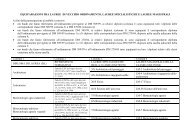
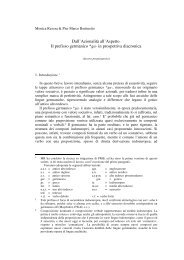
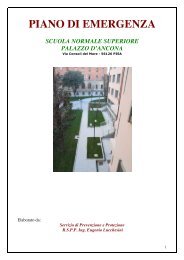
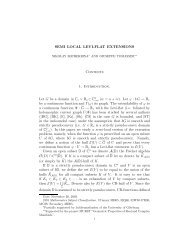
![4. Ghost [Å] vowels in French - Laboratorio di Linguistica](https://img.yumpu.com/49999334/1/184x260/4-ghost-a-vowels-in-french-laboratorio-di-linguistica.jpg?quality=85)


